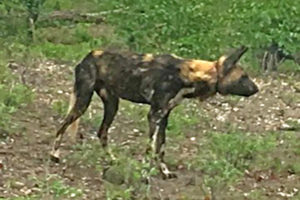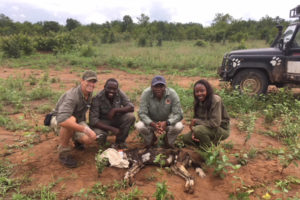
Early last week a snared painted dog was spotted by some guides at the Kashawe Wilderness Camp in Sinamatella. The dog was a member of an un-collared pack of 18 dogs that had been moving around that area. Because painted dogs are notoriously difficult to track down and find, a team from Painted Dog Conservation (PDC) was immediately dispatched to keep a sharp eye out for them with a view to immobilizing the unfortunate animal in order to remove the snare.

The dogs were found shortly thereafter on an overcast day with light drizzling rain that not only made darting conditions difficult but also meant the dogs had taken shelter under bushes and Mopane scrub which made them hard to see and even more challenging targets to dart. It took some time to scrutinize each of the 18 well-hidden dogs before the team managed to identify the snared animal and it took even longer for the PDC driver to navigate the Land Rover between the rocks, mopane stumps and broken vegetation to get into a suitable position to dart the dog. Despite their best efforts, they simply couldn’t do it. Each time they narrowed the distance and tried to get into darting range, the snared dog got up and move off to a new position. Time was running out. There is usually a cut-off time after which a darter will not attempt to dart an animal for fear of losing it in the fading light and that cut-off time was rapidly approaching. As a last resort, a decision was made to dart any dog that presented a good target so that a tracking collar could be fitted that would make it much easier to find this large pack and afford another opportunity to rescue the snared dog.
 Lady Luck was on sides, and within minutes the alpha male dog from the pack stood up at a distance of 20m and presented a fleeting but clear target through the lush vegetation. The dog was immobilized, collared and a short while later got to his feet and casually walked off into the bush.
Lady Luck was on sides, and within minutes the alpha male dog from the pack stood up at a distance of 20m and presented a fleeting but clear target through the lush vegetation. The dog was immobilized, collared and a short while later got to his feet and casually walked off into the bush.
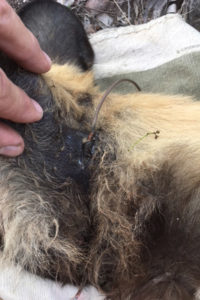 Two days later the VHF signal from the recently collared animal led the team directly to the pack of dogs. It didn’t take long to identify and immobilize the snared animal, and it quickly became apparent that the snare wound was a particularly bad one. A short 8-inch length of snare wire protruded from the left side of the dog’s neck and a 2-inch piece protruded out of the right side of his neck plus what looked like part of a twisted knot of the high tensile wire snare protruded from the trachea area. The rest was tangled and buried beneath skin and scar tissue within the dog’s neck.
Two days later the VHF signal from the recently collared animal led the team directly to the pack of dogs. It didn’t take long to identify and immobilize the snared animal, and it quickly became apparent that the snare wound was a particularly bad one. A short 8-inch length of snare wire protruded from the left side of the dog’s neck and a 2-inch piece protruded out of the right side of his neck plus what looked like part of a twisted knot of the high tensile wire snare protruded from the trachea area. The rest was tangled and buried beneath skin and scar tissue within the dog’s neck. 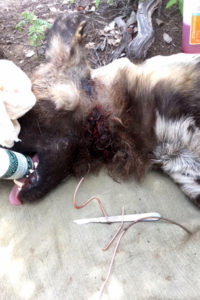 It was quite a daunting sight but there was no time to lose. Paul de Montille of D.A.R.T carefully tried to feel how the snare was positioned beneath the dog’s skin and figure out how he could extract it without damaging the animal’s trachea. He worked out that the stiff cupro-steel wire had somehow become looped under the skin.
It was quite a daunting sight but there was no time to lose. Paul de Montille of D.A.R.T carefully tried to feel how the snare was positioned beneath the dog’s skin and figure out how he could extract it without damaging the animal’s trachea. He worked out that the stiff cupro-steel wire had somehow become looped under the skin.  With some painstaking re-positioning of the snare, and a few careful snips with the bolt-cutters he was able to cut the snare into three separate pieces and extract them through each of the small holes where they had been protruding. The wounds were cleansed and dressed before the anti-dote was administered.
With some painstaking re-positioning of the snare, and a few careful snips with the bolt-cutters he was able to cut the snare into three separate pieces and extract them through each of the small holes where they had been protruding. The wounds were cleansed and dressed before the anti-dote was administered. 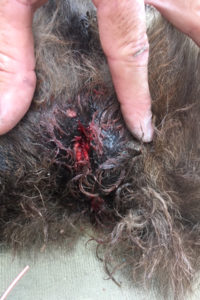
This was a rather a stressful operation, but removing the horrible device and relieving the Painted Dog of such intense pain and discomfort was immensely satisfying. Not only was the snare removed, but the collar fitted to the alpha male will make it much easier for the PDC team to keep a close watch on these wonderfully special and highly endangered animals.
Grateful thanks must go to the following:
Hwange Conservation Society UK who donated all the essential darting equipment and precision range finder that made it possible to accurately dart these dogs under such challenging conditions.
D.A.R.T for darting the animal and removing the snare.
Friends of Hwange Trust who provided the immobilizing drugs and surgical cleansing medication.
The Painted Dog Conservation team for all the hard work in finding, monitoring and observing these endangered animals throughout the Park.
The National Parks and Wildlife Management Authority of Zimbabwe, particularly the Sinamatella Park Rangers who provided invaluable assistance in the field.
